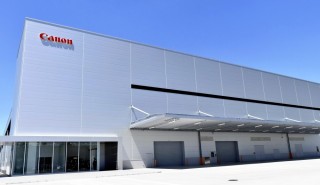Loading
Search
▼ Canon Opens Semiconductor Manufacturing Systems Factory North of Tokyo; Improving Processes with Nanoimprint Technology
- Category:Other
Canon Inc. unveiled its new factory in Utsunomiya primarily for manufacturing lithography systems, which use light to expose minute circuit patterns onto semiconductor substrates, to the press on Wednesday.
It is the first time for Canon to establish a new semiconductor manufacturing equipment factory in 21 years since 2004. The company is responding to the growing demand for manufacturing equipment due to the rapid expansion of the semiconductor market.
The company has invested ¥50 billion in the new factory, which has a total floor area of 67,518 square meters. It will begin operations in September and aims to reach full capacity in 2027 or later. Combined with the output of the company’s other two factories, production capacity will exceed 300 units per year.
Fujio Mitarai, Canon chairman and CEO, said at the opening ceremony on Wednesday, “The importance of semiconductors is increasing. It is our duty to strengthen our system for the stable supply of equipment.”
Canon sold 233 semiconductor lithography systems in 2024. In terms of unit sales, it holds approximately 30% of the global market share, ranking second behind ASML Holding NV of the Netherlands. However, in the advanced semiconductor sector, ASML dominates the market with its extreme ultraviolet (EUV) lithography systems.
Canon will produce not only conventional equipment but also “nanoimprint” lithography systems for advanced semiconductors at the new factory.
Nanoimprinting presses circuit patterns onto substrates like a stamp, simplifying the semiconductor manufacturing process compared to conventional lithography systems, offering advantages such as reductions in both production costs and power consumption.
Canon plans to expand into the advanced semiconductor sector through mass production of nanoimprint lithography systems.
Demand for semiconductors is growing due to widespread adoption of AI and other factors. According to the World Semiconductor Trade Statistics (WSTS), the global market is expected to grow 8.5% year-on-year to approximately $760 billion (approximately ¥116 trillion) in 2026. Some estimates predict the market will reach $1 trillion by 2030.
Japan’s semiconductor manufacturing equipment holds a strong competitive position in the global market. According to the Finance Ministry’s trade statistics, exports in 2024 reached ¥4.496 trillion, setting a record high.
- August 1, 2025
- Comment (0)
- Trackback(0)


